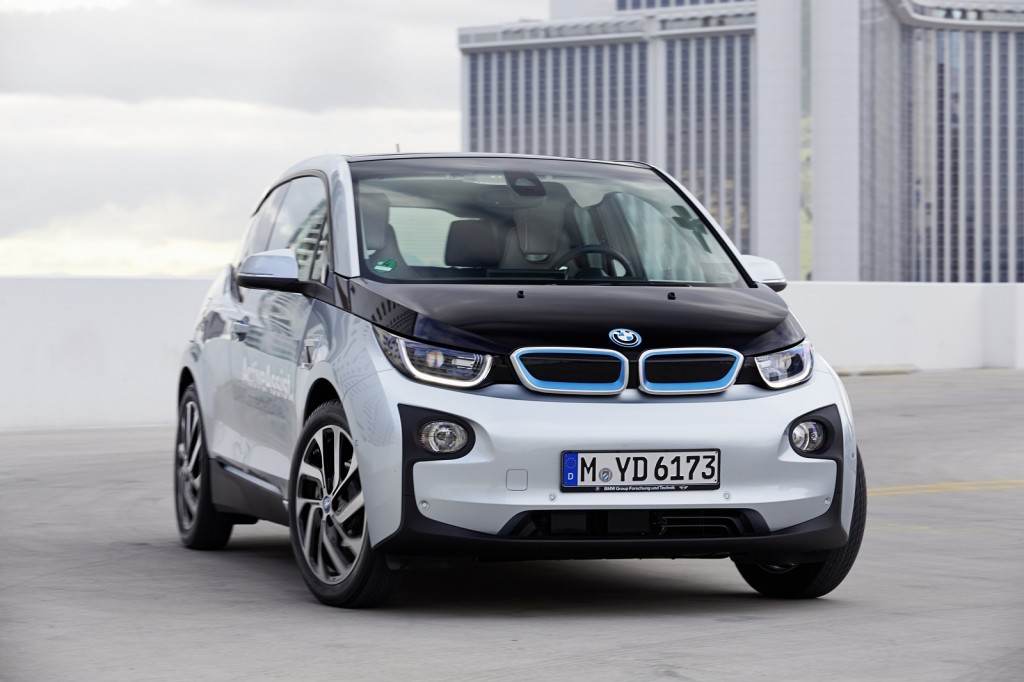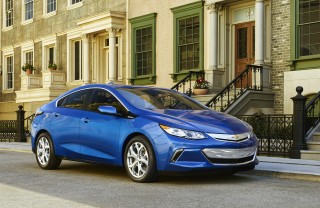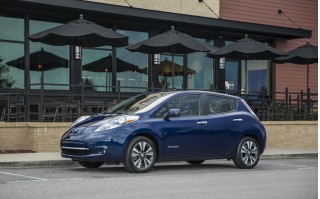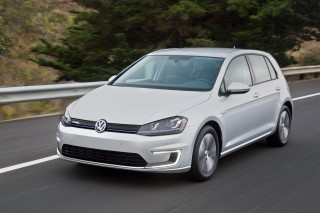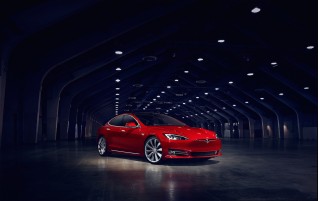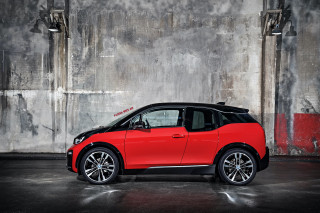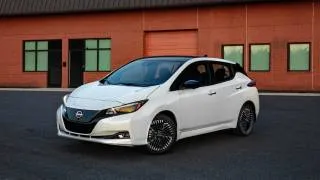Likes
- Powerful, smooth acceleration
- Agile low-speed handling
- Elegant, spare interior
- Simple one-pedal driving
- Range extender option
Dislikes
- Design is polarizing
- Wheel hop, body roll "not very BMW"
- Rear-seat riders can't open doors
- Electric range below 100 miles
Buying tip
features & specs
The 2016 BMW i3 is a futuristic and different kind of car, not just a new take on what a BMW represents.
The 2016 BMW i3 is clearly the car most unlike any other on the BMW showroom floor, and we think that's the point. Unlike the brand's reputation for performance, it's the most energy-efficient car sold in the U.S. this year—for the third year in a row. It represents nothing less than something of a revolution for the whole auto industry. The five-door small hatchback has advanced technology in spades, a body structure made of carbon-fiber reinforced plastic, and a fully electric powertrain that can be ordered with an optional two-cylinder range extender (REx) derived from a motorcycle engine.
This funky city car is meant to provide quiet, all-electric transport for those living in congested urban centers. The resulting BMW i3 is absolutely the most calming, soothing vehicle we've driven in truly chaotic rush-hour traffic. It works fine on highways and open roads, of course, though its roadholding is different in character and limits than any other BMW.
But the i3 isn't supposed to appeal to BMW M buyers. The electric i3's genius—providing a calm, soothing, capable experience through crowded urban areas—is intended for packed city cores and the crowded neighborhoods of Amsterdam, Jakarta, or Tokyo. In the U.S., it'll sell in and around traditional big cities like New York, Boston, and San Francisco, as well as more affluent areas surrounding cities like Atlanta, Dallas, and Los Angeles. But while the i3 remains a far cry from what U.S. buyers associate with BMW, it's sold in higher numbers than most analysts expected—1,000 units in some months, catapulting BMW to the front ranks of electric-car makers as a percentage of their total output.
If you didn't see the i3's blue-and-white roundel badge and twin-kidney (simulated) grilles, you'd never associate it with the rest of the BMW lineup. The i3 has a broad stance, with its large, 19-inch wheels pushed out to the corners, and an upright posture that makes it look bigger than it is. But the i3 launches a new design language for the brand's "i" plug-in cars.
They'll all have that mock twin-kidney grille outlined in blue, along with glossy black roofs, hoods, and trunklids or tailgates. The front and side of the i3 are distinctive, but the rear is a jumbled intersection of straight lines, curves, and materials—by far its least attractive angle. Inside, a modern, calm, almost minimalist cabin feels expansive in the front, but remains cramped in the rear. The interior evokes spacious, open loft living (and the car shows you not only roads but walking routes, bus or train schedules, and multiple transport modes). BMW says the i3 has as much interior volume as its 3-Series sedan, but it's organized differently—and we suspect most i3s will be occupied by only one or two people most of the time.
The 22-kilowatt-hour lithium-ion battery under the floorpan gives a range of 81 miles in the battery-only version. An optional 650cc two-cylinder range-extending (REx) engine produces 34 horsepower (25 kilowatts) and 40 pound-feet of torque. It doesn't power the wheels, but simply runs a generator to recharge the battery, boosting the car's range from the 72 miles its battery provides to perhaps 150 miles between fill-ups. That's thanks to a tiny gas tank holding less than 2 gallons, purposely made to comply with complex California regulations on zero-emission vehicles.
A 125-kilowatt (170-hp) electric motor allows the i3 to accelerate swiftly and smoothly from a stop. The truly distinctive feature, however, is the strong regenerative braking (up to 50 kW) that permits the i3 to be driven largely by modulating the accelerator only—touching the brake pedal is really only necessary when full stopping power is needed. The strong regen distinguishes the electric BMW from electric cars tuned to mimic the behavior of conventional cars with automatic transmissions, complete with idle creep. It's easy to get used to; once learned, many drivers will never want to go back.
The i3 is rated as the single most energy-efficient electric car sold in the U.S. The battery version earns a rating of 124 MPGe, the highest of any electric car tested. (The Mile Per Gallon Equivalent unit, or MPGe, measures the distance that a car can cover electrically on the same amount of energy that's contained in one gallon of gasoline.)
Recharging to 80 percent of battery capacity takes less than 4 hours using BMW's own home charging station, with a rating up to 7.4 kilowatts—higher than any other plug-in car except the Tesla Model S. BMW i3 cars offer a Combined Charging System quick-charging port as well, although today there are only a handful of public charging stations using that standard.
Aside from some wind noise at speed, the cabin is quiet and motor whine is well suppressed outside of full acceleration. The car is nippy and its small turning circle and compact dimensions make it easy to use in crowded cities. But the tall, very narrow tires have stiff sidewalls and produce a firm ride, without the grippy handling that is expected from any traditional BMW. It's perfect for zipping around town—quiet, comfortable, peppy—but it's certainly not the car you'll take to a slalom course. Still, the i3 is comfortable to ride in, with excellent front seats and bright, crisp graphic displays.
The i3 hasn't been tested by the NHTSA or the IIHS, but its unique carbon-fiber reinforced plastic body shell—mounted on an aluminum platform that contains the running gear and front and rear crash structures—should receive good crash scores. (The low volume of the i3 may mean that neither organization will ever crash test the car.) It also includes most of the latest electronic active-safety features found in luxury brands.
Instead of trim levels, BMW has chosen to sell the i3 and i8 in futuristic-sounding "Worlds." The base is the Mega World, followed by the Giga World for $1,500 extra, and the Tera World for another $1,000. Each world has its own stylistic differentiation, as well as wheel designs, upholstery choices, and interior colors. Standard equipment includes DC fast-charging, heated front seats, and satellite radio. Beyond the worlds, BMW offers some option packages—one for parking assist and another for driver-assistant features and technology—as well as some standalone options, including 20-inch wheels and premium sound. A BMW-branded charging station is available as an accessory.
The price starts around $43,000 for the Mega World version of the battery-only BMW i3. The REx range-extending engine adds almost $4,000 to the price, and it's easy to take a top-level BMW i3 past the $50,000 mark.
2016 BMW i3 Styling
The 2016 BMW i3 is a distinctive shape that likely isn't to all tastes, but the simple, elegant modern interior shows spare can be luxurious.
The 2016 BMW i3 remains a unique and distinctive design, three years into its life. While it has a few traditional BMW design cues—a twin-kidney "grille" plastered on the front—BMW's volume electric car adopts a unique design language that's used on for its "i" range of plug-in vehicles. it's all part of BMW's plan to differentiate its wildly divergent mobility concept in looks as much as in their structure and powertrain technology.
The blue hue that rings the blacked-out mock grille up front—BMW calls it Frozen Blue—can be found all over the "i" cars, including on the lower door trim. Another "i" signature is the shiny black surface texture used on the roof, hood, and tailgate, as well as on other details.
The BMW i3's design is most successful from the front, front three-quarter, and side views. The snub nose and tall, distinctive profile, in combination with the i3's wide stance and wheels-at-the-corners look, give it a solid presence that belies its relatively small footprint. Big chunky door handles reinforce the sturdy image. The large and handsome 19-inch wheels help give it gravity as well, although the narrow tires can be distracting to the eye when the car is viewed with its front wheels cocked—that's when they look too small for their openings.
Along the flank, there's a deep dip in the belt line to make the windows in the rear doors taller. It's followed by a jog up to a higher base for the third window in the rear pillar, which is echoed by a dip down from the roofline that makes that last window quite short. But at the back of the car, it all goes somewhat wrong, dissolving into a confusing blend of straight lines and curves.
The rear fascia and bumper shield sweep back and up to the base of the high load deck (below which hide the traction motor and drive unit). The U-shaped tail lights, hidden under the darkened glass of the rear hatch, are outlined with a mix of curved and straight shapes. But the body sides extend slightly past the tailgate below the window line, giving the i3 either vestigial tail fins or perhaps jowls. Overall, the rear of the i3 is the least-successful aspect of a distinctive design.
The cabin interior is equally distinctive, but in a different way. It's unlike any BMW you've seen before—and more akin to a loft living room with Scandinavian modern furniture. A small screen behind the steering wheel sits proud of the dash surface, rather than enclosed in a binnacle like virtually every other car's.The 10.2-inch central display screen, controlled via the iDrive knob on the console, also sits on a stalk above a useful wide and shallow bin in the top surface of the dashboard.
The interior is as simple and elegant as we've seen in any car. The textiles are tightly woven, in light or dark colors, and while you can get the mostly black treatment, you can also have a lighter, more living-room-like palette of greys, creams, and earth tones with contrasting stitching. It's unlike anything else BMW sells, as are the interior panels made of kenaf, a renewable fiber, though to our eyes their mottled finish looks unfinished. It's fine for the far part of the dash top, but the portions of the door panels finished that way rather look like they've had their covering stripped off.
Details can be finished in a variety of materials and colors. The basic Mega World includes recycled SensaTec upholstery with an instrument panel finished in what BMW calls grain foil. Step up to Giga World, and you get a combination of active-climate wool and olive-leaf tanned leather upholstery in soft earth tones, complemented by a leather instrument panel and details rendered in open-pore eucalyptus.
The top Tera World includes similar materials but covers most of the interior in a very dark brown hue. There are (inevitably) molded black plastic elements to the interior, but they're in the background, with the lighter and more novel materials catching the eye.
2016 BMW i3 Performance
The 2016 BMW i3 excels in tight city traffic, but its handling isn't what many BMW owners will expect from the brand.
The 2016 BMW i3 continues to be the sole battery-electric vehicle that offers an optional range-extending engine, which roughly doubles its rated range. While BMW doesn't break out sales of the two versions, in the U.S. many customers appear to want the security of the engine so they are constrained only by stops for fuel, and not longer stays at still-hard-to-find DC fast-charging stations using the CCS connector.
A 22-kilowatt-hour lithium-ion battery pack is mounted in the floor of the i3, and is liquid-cooled to prolong cell life. It sends current to a 125-kilowatt (170-horsepower) electric motor that drives the rear wheels and produces 184 pound-feet of torque. The motor is sited under the load deck to the left of the differential; empty space at the right can be occupied by the optional range extender (REx) and generator package.
BMW is the world's only carmaker to offer a range-extending combustion engine as optional equipment in a battery-powered car. It's a motorcycle-based 650cc two-cylinder that puts out 34 horsepower (25 kilowatts) and 40 lb-ft of torque. It doesn't power the wheels directly, but simply runs a generator that recharges the battery, boosting the car's range from the 81 miles of the battery-only version to perhaps 150 miles or so between refills. (The rated electric range of the REx version falls to 72 miles, due to the extra weight of the engine, gas tank, and associated plumbing.)
The tiny tank in the i3 REx holds less than 2 gallons, due to arcane California rules on zero-emission vehicles. That means frequent short fill-ups on long trips. But its main drawback is that under sustained heavy loads, the range extender simply can't generate enough sustained electric current to provide the car with full power. It only happens on long, steep grades or at highway speeds under full accessory use, but it can be startling to novices and potentially hazardous. It's something every owner needs to be aware of.
The BMW i3 has smooth continuous torque from takeoff, like all electric cars. The battery-only model accelerates from 0 to 60 mph in 7.0 seconds, with the heavier Range Extender model taking 7.8 seconds. But it's quick around town: 0 to 35 mph takes just 3.5 seconds for the EV. Top speed is quoted as 93 mph for both versions; we saw 83 mph with the car still accelerating. Highway driving erodes battery range more quickly, of course, making the range extender a better option for those with high-speed commutes of 40 miles or more.
Underway, the i3's crisp response, nimble handling, and tight turning circle of 32.3 feet make it a joy in navigating crowded city streets. The i3 is also a fine highway car, within the limits of its range, but we found it sensitive to sidewinds (no doubt a result of its tall body) and quite firm-riding. The ride is well controlled, but the stiffer sidewalls of the very tall, narrow tires mean it's not soft.
During a handling test, it was relatively easy to get the front tires to squeal on fast, sharp turns. We also noticed that the rear of the car jittered and skipped in fast cornering on broken surfaces. And because the car's heavy battery pack is mounted low, in the floor, but occupants sit straight up on top of it, the sensation of body roll is amplified. The BMW i3 rides well enough, but it's not a car you're going to want to take to track days or slalom courses.
To start the i3, the proximity fob must be in the car, and the driver's foot must be on the brake pedal. The start button is on the inside of a rotary controller behind the steering wheel on the right that lets the driver choose forward or reverse, and also holds a "Park" button. The electric parking brake is far enough back on the tunnel, at the base of the storage bin and armrest, that we had to have it pointed out to us.
Buttons on the console let the driver select "Eco Pro" or "Eco Pro+" mode, to stretch battery range a bit further (BMW says about 12 and 25 percent, respectively). A kickdown function in the accelerator lets drivers override either Eco Pro mode when sudden performance is needed on short notice. Unlike Eco modes in most other cars, the BMW i3's efficiency modes leave the car responsive and capable of keeping up with traffic. The Eco Pro+ setting more aggressively restricts the energy devoted to heating or cooling the cabin; it's the "wear a down jacket" setting that will keep the car going as far as it can in cold weather.
Regenerative braking in the i3 differs from that in most other electrified cars. It begins immediately when letting up on the accelerator pedal, rather than the car freewheeling, which allows drivers to make most trips with only occasional stabs of the brake pedal for complete stops. BMW's approach distinguishes the i3 from electric cars that mimic the behavior of a gasoline car with an automatic transmission. There's no idle creep, though we didn't miss it.
BMW has retained a gliding or coasting mode, between acceleration and regeneration, although the software control is now so seamless that you have to watch the power display through the steering wheel to detect it. The strong-regeneration feature can catch new drivers unaware—on our first drive, lifting off the accelerator while going down a parking garage ramp slowed the car to a complete stop, pointed downhill—but it takes only a few minutes to learn, it works well, and offers true one-pedal driving. In most uses, once a driver has learned how to modulate the accelerator, the friction brakes rarely need to be used in real-world conditions. They're mostly for sudden or panic stops.
Based on several test drives of both versions, we expect the BMW i3 to deliver real-world range of 70 to 90 miles. Meanwhile, the BMW i3 is the most efficient car of any kind sold in the U.S. It earns an efficiency rating of 124 MPGe, or Miles Per Gallon Equivalent, a measure that indicates how far an electric car can travel on the same amount of energy that's found in one gallon of gasoline.
2016 BMW i3 Comfort & Quality
The 2016 BMW i3 is simple, quiet, soothing, and modern inside, making it the ideal urban warrior vehicle.
The 2016 BMW i3 provides a smooth, quiet ride, as do most electric cars. While it's comfortable for two people, accommodating four will require some compromises.
The i3's front seats were designed with extremely thin backs to keep both weight and material use down, but they're well bolstered and comfortable overall. The seating position is upright and higher than some other small cars, giving the driver a good view ahead at the level of other traffic. The tilting and telescoping steering wheel has an unusually wide adjustment range, making it possible for almost any size of driver to be comfortable.
Rear seating, however, is tight for full-sized adults—and we don't plan on the i3 carrying four people very often. Getting in and out is awkward, because the rear-hinged "carriage doors" are not full-sized doors, and the rear seat actually sits further back in the cabin than their openings reach. Despite its height, this is the shortest vehicle BMW sells, and it shows.
Also, rear passengers can't get out of the car on their own, the front-seat occupants have to open their own doors first. As with most cars that have their batteries in the floorpan, the feet of rear-seat passengers sit higher than they would in the foot well of a conventional gasoline car, so there's a bit of the knees-under-chin feel when sitting in back.
The cabin is wide considering the car's short length, but the base of the windshield is roughly two feet ahead of the display screens on top of the dash—which gives it an open feeling. As a result, while it feels like a much larger vehicle than it is, you forget about its small size until it's time to shoot through a traffic gap. While BMW says the i3 has interior volume comparable to its 3-Series sedan, the layout is very different—passengers sit more upright in the i3, and some of that volume is accounted for by the unusable, but welcome space between the steering wheel and windshield.
On the road, there's almost no whine from the motor or electronics inside the cabin, except occasionally at maximum power. That's a testament to BMW's noise insulation team, because you can certainly hear a whine from the outside when an i3 passes by. We did notice wind noise during our road tests, especially in gusty weather, but it wasn't intrusive. It would likely have been masked by mechanical noise in a conventional car, pointing out the different challenges electric-car designers must contend with.
2016 BMW i3 Safety
The 2016 BMW i3 still hasn't been crash-tested, which is disappointing, but it offers a wide range of standard and optional electronic safety systems.
The 2016 BMW i3 is one of the few mass-market cars sold with a body shell made of carbon-fiber reinforced plastic. It's mounted on a rolling platform made of aluminum that holds the battery, electric motor, and all the car's electronics, as well as its front and rear crash-energy absorption structures.
While the industry is very curious to see how such a car performs in crash testing, neither the federal government nor the IIHS has yet tested a BMW i3 for crash safety. Even after a crash at 40 mph, BMW says, the passenger compartment will stay intact, with energy dissipated safely around the occupants. The battery—built into the floorpan—is positioned and reinforced for maximum crash safety, with three separate systems to shut down all electric components in the event of an accident.
The i3 has the usual roster of six airbags, including dash-mounted front bags for the driver and front passenger, bags in the sides of the front seats, and side curtains over the windows that cover both rows. BMW notes that the bags built into the front seats are a brand-new design that's small enough to fit into the slim, lightweight seat frames.
The electric BMW also has all the mandatory safety systems including anti-lock brakes, electronic stability and traction control, and tire-pressure monitoring. Optional systems come as part of two packages: The Parking Assistant package bundles a rearview camera, parking sensors, and parking assist. The Technology + Driver Assistant package includes upgraded navigation with real-time traffic, adaptive cruise control with stop and go, city driving assist, and BMW Online.
Vision out the front of the i3 is good, except for the area blocked by a large rearview mirror and camera housing at the top center of the windshield, but right-side and rear three-quarter vision are only adequate. The rearview camera may be a must for some drivers, as the rear window is short and placed high up in the vehicle.
2016 BMW i3 Features
The 2016 BMW i3 is packed with technology and offers a wide range of electronic systems, especially for its size.
The 2016 BMW i3 remains one of the pricier electric cars in the group with ranges of 75 to 110 miles, but buyers get a remarkably innovative and technically advanced vehicle for their dollars. The base model starts above $43,000, and the unique range-extending (REx) 2-cylinder engine adds almost $4,000 more (and cuts the rated battery range somewhat). New colors aside, the i3 is unchanged for 2016.
BMW eschews what the rest of the world calls trim levels, with the German maker's i cars instead coming in a handful of "Worlds." The most basic among them, the Mega World, includes upholstery made from recycled plastic, a flat-faced 19-inch wheel design, and features such auto climate control, auto LED headlights, a basic navigation system, cruise control, HD and satellite radio, heated front seats, and a DC fast-charging capability using the Combined Charging Standard connector.
The next step up—though hardly 1,000 times as good, as its name would denote—the Giga World provides a different 19-inch wheel design, a universal garage-door remote, proximity key lock/unlock functionality, leather upholstery with wool cloth in earthy tones, and the Smoker's package. Finally, the Tera World (another increment of 1,000!) adds full leather in dark brown and its own 19-inch wheel design to the Giga's extras.
All Worlds and options are offered on both the battery-electric and range-extended models. Aside from the engine, the only real difference between the two comes on the Mega model, which wears 175-section rear tires on the REx, but 155-section tires all around on the battery-electric i3 version.
All three Worlds offer 20-inch wheels as an option, plus two available packages. The Parking Assistant package bundles a rearview camera, parking sensors, and parking assist itself. The Technology + Driver Assistant package includes upgraded navigation with real-time traffic, radar adaptive cruise control with stop and go, city driving assist, and BMW Online.
The sole standalone equipment option aside from the wheels is an upgraded Harman/Kardon stereo. Metallic paints are an optional extra as well, but despite grumbling by i3 buyers, no sunroof is offered as an option on regular production BMW i3 models.
2016 BMW i3 Fuel Economy
The 2016 BMW i3 is the single most energy-efficient car sold this year, and a small range-extending engine is a unique option.
Now in its third year, the 2016 BMW i3 remains the most energy-efficient vehicle sold in the U.S. That applies to the battery-electric version, but even with the optional Range Extender (REx) gasoline engine, the i3 scores well in EPA efficiency tests.
The i3 has an average rating for electric range—81 miles—but the i3's lightweight, purpose-built construction, and dedicated drivetrain have all been optimized around the goal of extracting maximum distance from every stored electron—and it works. The battery-only version of the i3 gets a rating of 124 MPGe, beating the new longer-range 107-mile 2016 Nissan Leaf, which is rated at 112 MPGe combined. (The MPGe unit describes the distance a car can cover using the same amount of energy from its battery as is contained in one gallon of gasoline.) Models equipped with the range extender beat the Leaf too, with a score of 117 MPGe combined.
Using a BMW 240-volt Level 2 charging station, the i3's onboard charger runs at up to 7.4 kilowatts, higher than the 6.6-kw charging that's standard in the Nissan Leaf. That will recharge its battery pack in about 4 hours. Installing the BMW charging station may require some home electrical work, but no more than what's needed to install an electric stove or clothes drier. On standard 120-volt household current, the recharge will take up to 16 hours.
The BMW i3 comes standard with a DC quick-charging port that works on the Combined Charging Standard protocol—although so far there are fewer stations using that standard than there are CHAdeMO stations that can be used by a Leaf. However, virtually all new DC quick-charging stations now being installed are "dual-standard," with two cables, one for each protocol.
This site rates every battery-electric vehicle at 10 on our "Green" scale. The differences in efficiency among plug-in electric cars matter less than their ability to run on grid power, which automatically makes them some of the greenest cars you can buy. Even if an electric car is recharged from the oldest, dirtiest coal power plants in the nation, it remains cleaner—comparing "wells-to-wheels" carbon emitted through the process of creating and transporting the fuel as well as powering the car—than any gasoline car sold today that isn't a hybrid.
In California, which will see more plug-in sales than the next five states combined, the grid is relatively clean, so parity with any gasoline car soars toward unattainable numbers like 80 or 90 mpg. And while the cost per mile varies with what you pay locally for a kilowatt-hour of electricity, the i3's running cost per mile will be very low compared to its gasoline or diesel siblings on the showroom floor.
